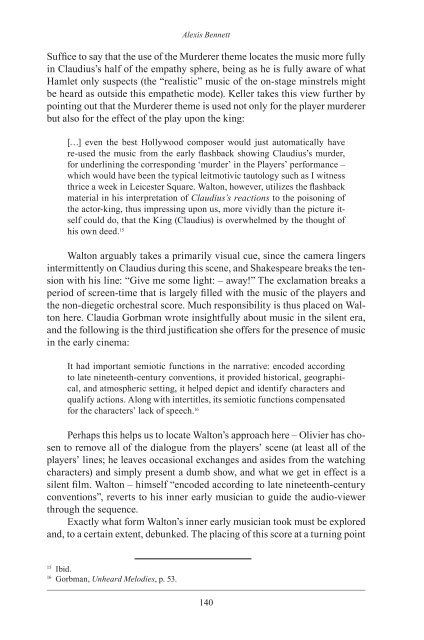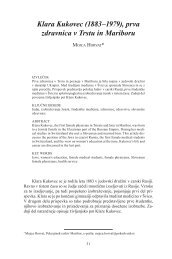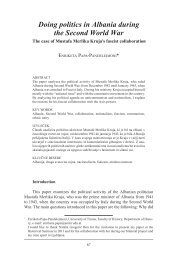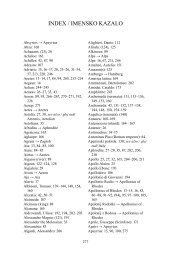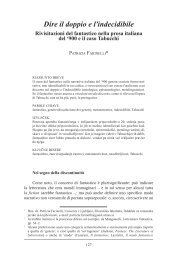HS 9 - HistoriÄni seminar ZRC SAZU
HS 9 - HistoriÄni seminar ZRC SAZU
HS 9 - HistoriÄni seminar ZRC SAZU
You also want an ePaper? Increase the reach of your titles
YUMPU automatically turns print PDFs into web optimized ePapers that Google loves.
Alexis Bennett<br />
Suffice to say that the use of the Murderer theme locates the music more fully<br />
in Claudius’s half of the empathy sphere, being as he is fully aware of what<br />
Hamlet only suspects (the “realistic” music of the on-stage minstrels might<br />
be heard as outside this empathetic mode). Keller takes this view further by<br />
pointing out that the Murderer theme is used not only for the player murderer<br />
but also for the effect of the play upon the king:<br />
[…] even the best Hollywood composer would just automatically have<br />
re-used the music from the early flashback showing Claudius’s murder,<br />
for underlining the corresponding ‘murder’ in the Players’ performance –<br />
which would have been the typical leitmotivic tautology such as I witness<br />
thrice a week in Leicester Square. Walton, however, utilizes the flashback<br />
material in his interpretation of Claudius’s reactions to the poisoning of<br />
the actor-king, thus impressing upon us, more vividly than the picture itself<br />
could do, that the King (Claudius) is overwhelmed by the thought of<br />
his own deed. 15<br />
Walton arguably takes a primarily visual cue, since the camera lingers<br />
intermittently on Claudius during this scene, and Shakespeare breaks the tension<br />
with his line: “Give me some light: – away!” The exclamation breaks a<br />
period of screen-time that is largely filled with the music of the players and<br />
the non-diegetic orchestral score. Much responsibility is thus placed on Walton<br />
here. Claudia Gorbman wrote insightfully about music in the silent era,<br />
and the following is the third justification she offers for the presence of music<br />
in the early cinema:<br />
It had important semiotic functions in the narrative: encoded according<br />
to late nineteenth-century conventions, it provided historical, geographical,<br />
and atmospheric setting, it helped depict and identify characters and<br />
qualify actions. Along with intertitles, its semiotic functions compensated<br />
for the characters’ lack of speech. 16<br />
Perhaps this helps us to locate Walton’s approach here – Olivier has chosen<br />
to remove all of the dialogue from the players’ scene (at least all of the<br />
players’ lines; he leaves occasional exchanges and asides from the watching<br />
characters) and simply present a dumb show, and what we get in effect is a<br />
silent film. Walton – himself “encoded according to late nineteenth-century<br />
conventions”, reverts to his inner early musician to guide the audio-viewer<br />
through the sequence.<br />
Exactly what form Walton’s inner early musician took must be explored<br />
and, to a certain extent, debunked. The placing of this score at a turning point<br />
15<br />
Ibid.<br />
16<br />
Gorbman, Unheard Melodies, p. 53.<br />
140


